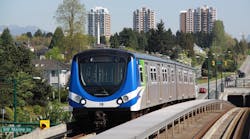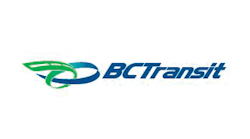Governments of Canada and British Columbia to provide C$16.8 million in joint funding to expand NextRide technology in British Columbia’s public transit system
The governments of Canada and British Columbia will provide joint funding of C$16.8 million (US$12.7 million) to expand NextRide technology in British Columbia’s public transit system.
NextRide uses state-of-the art technology such as Automatic Vehicle Location (AVL) hardware and Computer Aided Dispatch (CAD) software to improve data collection for public transit systems. The investment will enable the procurement of AVL hardware and CAD software for up to 638 buses within 21 regional transit systems across British Columbia. It will also enable improvements to public transit accessibility, with automatic voice annunciators and visual displays in buses for upcoming stops.
Expanding NextRide technology will ensure BC Transit’s conventional fleet is using one operational data solution while providing important information about current vehicle locations, schedule adherence, breakdowns and other emergencies. It will also pass real-time location information to transit users through vehicle head signs and mobile and third-party web-based applications.
“An upgraded NextRide will offer our customers real-time transit information about bus locations, route schedules and detours. This modern technology helps riders better plan their travel, saving them time as they go about their day. We’re thankful to work with our funding partners to bring NextRide to our transit systems across the province, and we look ahead with excitement, as we start planning the implementation of this upgraded and expanded service,” said Erinn Pinkerton, president and CEO of BC Transit
Updating the technology used by regional transit systems across the province will allow riders to plan their trips accordingly. Improving the reliability and efficiency of public transit encourages more people to choose cleaner modes of transportation.
“Investing in modern technology and data solutions is a sure-fire way to improve the reliability and efficiency of public transit. Expanding NextRide technology across the province will encourage ridership by allowing British Columbians to plan their commute in real-time and track when their bus will arrive and depart. Our government remains committed to improving public transit infrastructure and building greener, more accessible, and better-connected communities,” said Member of Parliament for West Vancouver—Sunshine Coast—Sea to Sky Country Patrick Weiler.
The government of Canada is investing C$5.7 million (US$4.3 million) in the project while the government of British Columbia is contributing C$6.7 million (US$5.1 million). Local governments are contributing C$4.3 million (US$3.2 million).
The government of Canada’s funding comes from the Public Transit Infrastructure Stream of the Investing in Canada Infrastructure Program. The stream supports the building, expansion and upgrading of urban and rural transit networks. In British Columbia, 48 infrastructure projects or project bundles under the Public Transit Infrastructure Stream have been funded, with a total federal contribution of more than C$2.4 billion (US$1.8 billion) and a total provincial contribution of nearly C$3.7 billion (US$2.8 billion).
The government of Canada is investing C$14.9 billion (US$11.73 billion) over the next eight years in reliable, fast, affordable, and clean public transit. This includes C$3 billion (US$2.36 billion) per year in permanent, predictable, federal public transit funding, which will be available to support transit solutions beginning in 2026-2027.
Since 2015, the government of Canada has invested more than C$24.8 billion (US$18.8 billion) in transit projects across the country, providing Canadians with cleaner and more efficient commuting options.
Under the Investing in Canada Plan, the federal government is investing more than C$180 billion (US$136.8 billion) over 12 years in public transit projects, green infrastructure, social infrastructure, trade and transportation routes and Canada’s rural and northern communities.
“Our government continues to invest in public transit infrastructure that makes taking the bus more reliable. The expansion of real-time bus location information across regional transit systems in our Province makes it easier and more convenient for British Columbians to plan their bus trips online, which saves people time and makes cleaner modes of travel more accessible for everyone,” said British Columbia Minister of Transportation and Infrastructure Rob Fleming.



